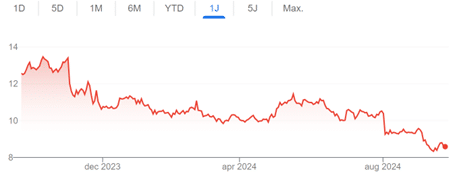The Dutch staffing company Brunel is a globally operating specialist employment agency, active in various fields, including energy, engineering and IT. Brunel distinguishes itself from its competitors by its focus on highly qualified specialists and niche markets, such as the oil and gas industry and renewable energy, combined with a strong global presence.
Employment agencies are generally considered early cyclical. This is because companies are more likely to hire temporary staff during an economic recovery before they hire permanent employees. Conversely, temporary workers are often the first to be laid off during an economic downturn. Although the results are not looking good at the moment and there is no concrete recovery visible yet, the share is trading at a low valuation and pays an attractive dividend. Sharesunderten believes that Brunel should not be listed for less than ten euros and is therefore quickly seizing this opportunity and advising its members to do the same.

CEO change
Early July it was announced that the current CEO, Jilko Andringa, will step down at the end of this year. It has also been announced that Peter de Laat will be appointed CEO as of October 1, 2024. De Laat has been working at Brunel since 2012 and has fulfilled the role of CFO since 2014. He knows the company well and looks forward to further strengthening Brunel and leading the developments in the industry and markets. In the meantime, the Supervisory Board is looking for a successor to his current position as CFO.
Results
Table 1 shows the results of the first half year. Despite a strong turnover growth of 7.9% compared to last year, gross profit remains the same, causing the gross profit margin to decrease by 150 basis points. As a result, EBIT decreases by €2 million to €25 million, which is 7.4% lower than in the first half of 2023.
| (in million euros) | H1 2024 | H1 2023 | Difference |
| Turnover | 696 | 645 | 7,9% |
| Gross profit | 134 | 134 | 0,0% |
| Gross profit margin | 19,3% | 20,8% | -1,5% |
| Ebit | 25 | 27 | -7,4% |
| Ebitmarge | 3,6% | 4,2% | -0,6% |
| Net profit | 15 | 16 | -6,3% |
| Net profit per share | € 0,30 | € 0,32 | -6,3% |
The results speak for themselves: Brunel is struggling. Despite rising turnover, profits are falling, partly due to inflationary pressure. The challenges in Germany and Asia are also not helping to improve the situation. However, ING analysts expect EBIT to grow by double digits next calendar year. In addition, Brunel’s management is counting on recovery from 2025.
Cost savings
In response to challenging market conditions across several regions, Brunel has announced significant cost savings to strengthen profitability. The company is implementing a cost savings plan worth €20 million, which equates to approximately 10% of operating costs. These savings are being driven by digital investments, including improvements to Brunel’s global IT infrastructure, which will increase efficiency and reduce support functions and management layers, without affecting sales capacity.
The company expects part of these savings (€4-5 million) to be visible in the second half of 2024, while the remaining amount (€14-15 million) will be realised in 2025. This plan is aimed at improving the conversion ratios (the ratio of EBIT to gross profit), which have so far lagged behind the targets. Through these measures, Brunel expects to be able to realise profit growth, even in the event of continued weakness in markets such as Germany.
Risks in Germany and delays in Asia
Brunel faces significant challenges in both Germany and Asia, two important markets for the company. In Germany, market conditions remain weak, particularly in the automotive sector, where volumes are declining and margins are being squeezed. This is causing continued uncertainty and is negatively impacting revenue growth. Despite cost-saving measures, no rapid recovery is expected in Germany in the coming quarters.
In Asia, Brunel is facing project delays in the conventional energy sector, with completions pushed back to early 2025. These delays have negatively impacted growth expectations for this region in 2024. While the long-term outlook, particularly in the renewable energy sector, remains positive, these short-term challenges are having a dampening effect on both profitability and growth in both regions.
Renewable energy
Brunel sees significant growth opportunities in the renewable energy sector, which is playing an increasingly important role in its strategy. Despite delays to some projects in Asia, the renewable energy project pipeline remains strong. This sector is seen as a key driver of future growth, with a robust order book for the remainder of 2024 and beyond. The focus on sustainable energy not only provides Brunel with the opportunity to capitalise on global energy transitions, but also to benefit from the increasing investment in green energy infrastructure. With major projects planned for 2025, Brunel expects its renewable energy activities to make a significant contribution to medium-term earnings growth.
Reason for confidence
Sharesunderonetientje sees strong opportunities in the sectors in which Brunel operates. Energy, and in particular renewable energy, is expected to experience significant growth. Brunel’s strategic focus on these sectors, combined with its global expertise and strong order pipeline, gives us confidence that the company is well positioned to benefit from the increasing demand for sustainable energy solutions. In addition, Brunel’s cost-saving measures, which are improving margins and conversion rates, provide a solid basis for profit growth, even in challenging markets such as Germany and Asia. The combination of these factors makes us positive about Brunel’s future.
Assessment and conclusion
Although no concrete recovery is visible in the results over the past half year and management itself does not expect this to happen in the next six months, Sharesunderten believes that investors are currently assuming a worst-case scenario. Analysts state that even in a full recession in Germany, the EBIT of the entire company will still grow by double digits in 2025.
With an expected net profit per share of €1.03 in 2025 and €1.21 in 2026, the price-earnings ratios for those years come to 8.3x and 7.1x respectively, while the historical median is around 19x. Given that founder Jan Brand, who is now 75 years old and has a majority interest of 60.05%, we do not rule out a takeover. With founder Jan Brand, who at the age of 75 has a majority interest of 60.05%, a takeover does not seem unthinkable in the long term.
Sharesundertenteen believes that a company like Brunel should not be listed for less than ten euros and therefore takes a position. With a target price of €14, the upside potential is around 70% %. In addition, the company pays a dividend yield of 6.4%, which is expected to increase to 7.1% in 2025.
How nice is it to have a share where, while you wait for a price increase or takeover, you simply earn a fat 6% return? That is why we are going all-in in our SUT portfolio with a full position of €3000 and we are rounding that up. That is rounded up to 400 shares at a price of approximately €8.70. Nice bonus, right?
Author has a position in Brunel
Major shareholder
Jan Brand: 60,05%
Fundamental data
Name: Brunel International NV
Ticker: BRNL
Sector: Employment Services
Exchange: Euronext Amsterdam
ISIN: NL0010776944
Price September 23: €8.56
52-week low: €8.31
52-week high: €13.58
Number of outstanding shares: 50.4 million
Market capitalization: €431 million
Price/earnings ratio 2024: 11.4x
Dividend: €0.55
Dividend yield: 6.4%
Tax. dividend yield 2025: 7.1%
Book value per share: €6.19
Q3 figures: November 1
Website: https://brunelinternational.net/overview/default.aspx


